Click on a part of the map to go to that area of the website.
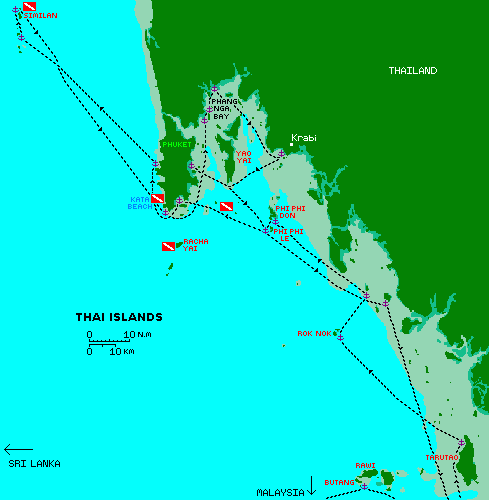
|
Indian Landfalls Thailand Pages Related Pages |
Thai Coast
| Our tracks and dive locations through coastal Thailand. Click on a part of the map to go to that area of the website.  |
Landscape: The Andaman coast of Thailand (ie. the western side of
the peninsula) is about 350 miles (600 km) long, and boasts hundreds of islands
offshore, the largest being Phuket (poo-KET) which has low hills and remnants of forest.
Other islands are steep-to with limestone cliffs and clear water. The Similans,
to the northwest of Phuket, are granite with crystal waters and white beaches.
Many of the islands are protected as National Parks. Phang Nga Bay to the NE of
Phuket has emerald green water (not clear) with fantastic limestone islands
jutting into the blue sky.
Population: The majority of people on this coast live on the island of
Phuket. They are a mixture of Sino-Thai and ethnic Thai, and most are Buddhist. A small
Muslim fishing village on stilts lies at the north end of Phang Nga Bay. In other coastal
towns people tend toward a mix of Chinese Buddhist and ethnic Malay Muslim. The ethnic mixes
reflect the fact that this coast is bordered on the north by Myanmar (Burma) and on the
south by Malaysia.
Visited: 1 January to 10 February 2007.
For more information (including GPS way points of the places we anchored) see our Terrific Thailand Newsletter.
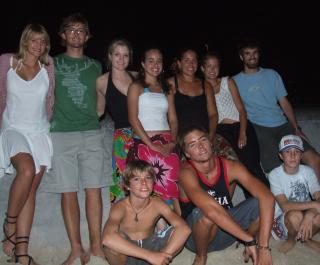 The Thai partyers: Sabine, Adam, Daniela, Lara, Amanda, Rachel, Chris, Marco, Warren & Taylor. |
(Amanda) The islands near Phuket, while surrounded by murky water, are party and tourism, non-stop. This worked out fabulously in my opinion because Chris was on board again, as was my friend Rachel, plus Adam and Warren were visiting their parents on Scud, and the boat Mahi Mahi had four teens/young adults on board. Party time! We had fun at Nai Harn bay on Phuket (south of Kata Beach), going out at night to a local reggae bar to play pool and dance, surrounded by the hundreds of paintings hung on the walls. In Phang Nga Bay we swam through hongs (caves) and wallowed in the deep, sucking mud at low tide. At Krabi Bay (actually east of Krabi) we went hiking up the hills and rock-scrambling and beach-walking by day, then went across the peninsula at night to find some night-life. Phi Phi Don would have been fun but we were there at a time when no other cruisers were, plus the anchorage was just TOO BUSY all day with day-charter power boats and long-tails going in and out, in and out.
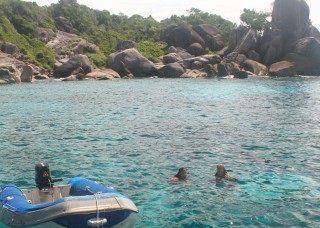 We loved the crystal waters of the Similans |
We spent some time in Ao Chalong, Phuket (big bay on the SE) shopping and doing boat maintenance. I eventually took my Advanced Diver course from there, along with Rachel and the Scud boys. We spent many hours ashore when we could, drinking fresh half-frozen limeade drinks, using the internet, walking in the rain, and playing pool. Otherwise much of our time there was spent groveling in the bilges, cleaning out the oil that our port engine spewed out. One memorable occasion was when I managed to get a full liter of used engine oil on my head. I blame my brother, but it was at least half my fault. I laugh at it now. I laughed then, too, but it was somewhat hysterical laughter and rather on the verge of tears. After that point, I made it clear I was having nothing to do with engine oil and bilges.
We got out to the Similan Islands once the engine was fixed, and it was SO
NICE. Beautiful water, friends around, snorkeling, swimming... I don't think I
actually went ashore (there's not much there, just untamed island), but it was
wonderful to get away from the hustle and bustle of Phuket. Of course power
boats came in every day from 10am to about 2pm and disgorged life-jacketed
tourists into the water to snorkel, but we locked ourselves in the boat and
played Scrabble when that happened (just
kidding ![]() ). I'm just
sad I was fighting off a nasty chest infection and couldn't dive, or it would
have been stupendously awesome, instead of being merely absolutely awesome.
). I'm just
sad I was fighting off a nasty chest infection and couldn't dive, or it would
have been stupendously awesome, instead of being merely absolutely awesome.
 Long-tail boats at Crocodile Cave, Tarutao |
(Sue) So many islands. So much to write about. I loved the feeling of jumping off from the Malay Peninsula to wind our way up through the islands of the Thailand coast. I had no idea what to expect. But I was pleasantly surprised to find many of the islands at the southern end uninhabited (except for a few national park people, and sometimes some backpackers.) On Koh Tarutao we and our buddies on Scud took our dinghies up a long mangrove-lined river to Crocodile Cave. It was our first introduction to the many limestone caves that dot these islands. Often you can enter in a kayak or dinghy, but this one involved a cliff-edge walk, then a slow barge ride (pulled by ropes) deep into the darkness. Very cool. The Siam crocodile no longer lives there, unfortunately.
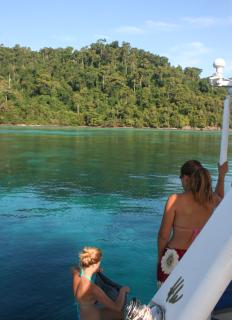 Amanda & Rachel, Ko Rok Nok |
We spent many days on the big island of Phuket, which is where we took care of officialdom like clearing in and out, paying harbor fees, seeing immigration, etc. It was also a great place to get caught up on routine medical checkups. The Phuket International Hospital in the center of the island has walk-in care for tourists. You can either pay a flat fee for a whole battery of tests and diagnostics (e.g. EKG, skin check for cancer, mammogram, etc) or pick and choose what you feel you need or want. If a problem is found the care is immediate, affordable, and First World. What I loved was that there was not only a dental clinic in the hospital, but a Traditional Medicine clinic where you could get acupuncture, reflexology, homeopathy, massage, etc. What a wonderful blending of East and West.
I was quite desperate for some clear water for swimming and snorkeling and was thrilled to find it at Ko Rok Nok. Chris got to use the (old) underwater camera, which subsequently died, but we did get a few shots of some new fish. At the end of our Thailand stay (actually as we were jumping off for Sri Lanka) we had a new camera and found beautiful clear water and good snorkeling over reefs in the Butang Islands also at the southern end of the chain. The best, though, was the Similan Islands, far offshore, 60 miles NW of Phuket. This is far enough that the normal tourist can only reach them by dive charter boat. While we sailed throughout all of these islands I felt so lucky to be visiting on our own boat which meant we could come and go as we pleased.
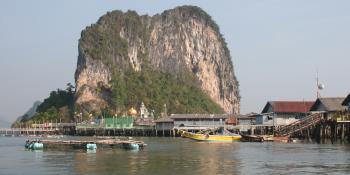 Floating Muslim village of Pan Yi, in Phang Nga Bay |
Phang Nga Bay was spectacular. It's enclosed to the east by the lower Thai peninsula, and to the west by the large island of Phuket. This is the area where the photos of unbelievable limestone cliffs and emerald water come from. What you can't tell from the photos is that the water is not clear for snorkeling -- the tidal changes and the fine sediment from the limestone create the green color, but made visibility very poor. Nevertheless, the cruising is wonderful amongst the dozens of islands and along the mainland coast. Although many islands are uninhabited, some have small fishing villages. The most interesting village was a floating Muslim village called Pan Yi, in the far northern corner of the bay. although it is rife with tourist boats and tourists at lunch time, in the evening and early morning there is no one there but the locals and we few cruising boats. We enjoyed walking the wooden plank "roads" of the village, poking into local shops and watching an old man teach young Muslim children to read.
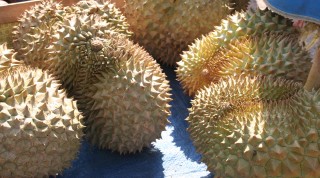 Soccer-ball sized durians with a world-size stink |
Phuket was also where we did our provisioning before heading off to the Similan Islands and up into Phang Nga Bay for a few weeks. There were at least 3 big modern malls with grocery stores, plus clothing and electronics shops to browse and spend money in. The best fresh fruits and veggies, though, were in the "wet" markets -- one located within walking distance of the main anchorage at Ao Chalong, the other a 20 minute tuk-tuk ride into Phuket town itself. Pineapple, papaya, bananas, plantain, oranges, breadfruit, jack fruit, rambutan (yummy), durian (stinky!), plus more kinds of greens than I could name. Of course there were also the Thai delicacies like cockroaches, frogs and crickets. (Crunchy!)
 Even monks get around in long-tail boats |
Probably our favorite anchorage on Phuket was Nai Harn Bay, to the west of Ao Chalong. The water here, while not very clear, was at least swimmable, so Tina (off Scud) and I could get in our hour a day exercise swim. It was easy to rent little cars (which we did) or motor scooters (which we didn't) to get around the island and run errands. In the evenings we frequented the restaurant at the north edge of the bay that was a Thai and yachtie hang-out with wonderful inexpensive Thai curries and fresh fish dishes. Off the tourist track, at one of the marinas on Phuket, we found other sumptuous dishes for mere pennies -- our favorite being a little 2-table place near the entrance to Boat Lagoon Marina.
Despite many of the westernizations of Phuket, we stayed acutely aware that we were in a Buddhist, SE Asian country. In front of every home was a "spirit house", and beautiful shrines and temples studded the sides of the roads and the back streets.
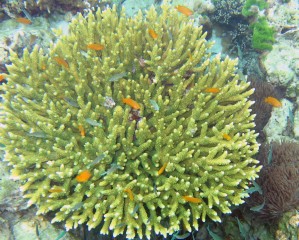 Damselfish flit about the coral at Ko Rok Nok |
(Jon) Thailand is actually a good place to get boat-work done. There are high-quality craftsmen (although you have to watch them closely to get their best work) and usually ample supplies are available. For example, we broke an obscure oil pipeline on our port-side engine on our way out to the Similans and when I contacted the local Yanmar dealer, he actually had one in stock and sold it to me for a very good price. Some boats did full refits in Thailand, getting new teak decks laid (only $10K) or having the whole boat repainted. We didn't have much time for that sort of work, but we did pull into a Boat Lagoon Marina for a few days to get some things sorted out that were going to be difficult for me to do by myself. Jo, a jovial ex-pat Aussie, organized much of the work and acted as translator for us. But as usual, we were very glad to finally leave the marina and get back to real cruising. While marinas allow us to walk off the boat easily (and in this case tap into the local WiFi network) the docks point the wrong way for the breeze to flow through the boat, and the surrounding condos block the breeze and make us feel like we're living under a hot, airless microscope. We have all the support services we need on board, and much prefer to be at anchor.
 The famous rock off James Bond Island |
Phang Nga Bay is about 40 miles (70 km) deep and opens to the south, between Phuket Island to the west and the Thai mainland (see Amanda's map, above). Throughout the bay are an array of limestone islands jutting up suddenly from the shallow, green water. Most of the movie and TV scenes of sailing in Thailand between towering rocks are shot in Phang Nga Bay. We visited the island where the island scenes from the James Bond classic "Man with the Golden Gun" were shot, recognizing much of the scenery.
We cruised this area for over a week with 2 other catamarans, poking through tunnels (some quite long) to discover towering "hongs" where the limestone had caved in, leaving a huge circular depression with sheer vertical walls of limestone, often with grotesque stalactites hanging down.
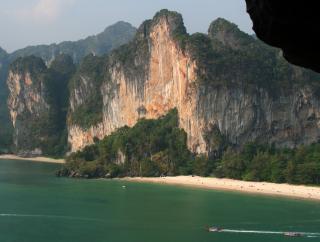 Amazing view from high on the cliffs near Krabi |
At the northern extreme of the bay is a Muslim village built entirely on stilts. They cater to thousands of tourists everyday, brought up from Phuket for lunch by powerful long-tails. Thankfully, they'd all left by the time we arrived. Unfortunately, the huge restaurants charge exorbitant prices for reputedly rather mediocre food, so we merely explored the village and the next morning we hired a long-tail with Mahi-Mahi and toured the surrounding mangroves and waterways.
But perhaps my favorite area was on the eastern side, at a peninsula labeled Laem Nang on the charts (8°01'N 98°37'E, about 6 miles or 10 km east of Krabi). There are a series of bays there, with several backpacker resorts and many restaurants sprinkled along the 3 long beaches but no road access at all because of the magnificent high limestone cliffs. We stayed there several days, swimming and exploring the many limestone caves and hongs. In the evenings we'd meet our cruising friends on the beach to discuss the day, watch the sunset, and decide which delightful and inexpensive restaurant we wanted to try that night. Some other cruising boats eventually joined us and at one point we had about 10 teens running around together. When the kids are happy, the whole boat's happy, and it was a very happy time for us at Krabi.
Thai Pages:
Related Pages:
Indian Ocean:
Top Level: Home | Destinations | Cruising Info | Underwater | Boat Guests | Ocelot | Sue | Jon | Amanda | Chris | Site Map | Make a Comment
|
If our information is useful, you can help by making a donation |
Copyright © 2000‑ Contact: Jon and Sue Hacking -- HackingFamily.com, svOcelot.com. All rights reserved.